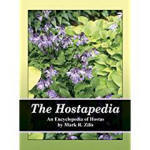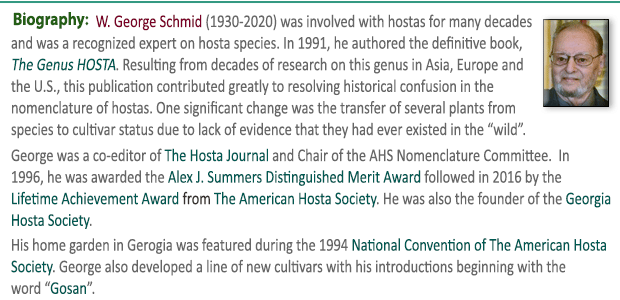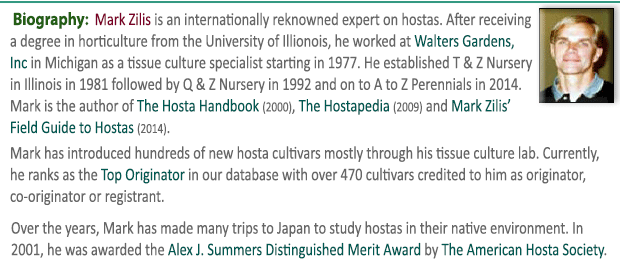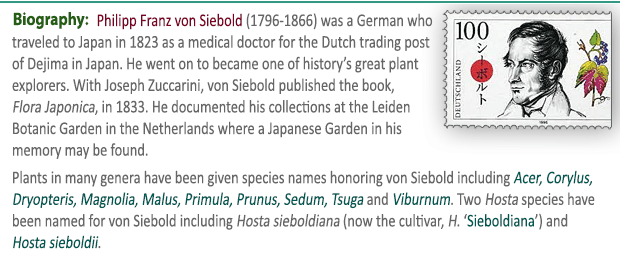|
  This is another
Japanese species that has a long history and which has had several different names. This species of small size (12 inches high) plants is found
in wet soils in their native lands. Plants have wavy, shiny
leaves about an inch wide and 4 or 5 inches long. The top of the
leaf is a matte, dark green while the bottom is shiny and
lighter green. Leafy bracts appear along the stem and near white
flowers are borne in August. The flowers have dark purple veins
in the tepals. This is another
Japanese species that has a long history and which has had several different names. This species of small size (12 inches high) plants is found
in wet soils in their native lands. Plants have wavy, shiny
leaves about an inch wide and 4 or 5 inches long. The top of the
leaf is a matte, dark green while the bottom is shiny and
lighter green. Leafy bracts appear along the stem and near white
flowers are borne in August. The flowers have dark purple veins
in the tepals. According to
The Hosta Handbook by Mark Zilis (2000), this plant has also been known as either Hosta albomarginata or
Hosta lancifolia albomarginata
in the past.
 The Hostapedia by Mark Zilis (2009), states, "Unfortunately, it was
designated as a species in 1838 and serves as the type for a
large taxonomic group of hostas (Schmid
1991, p. 99). For this reason, George Schmid chose not to
reclassify
Hosta sieboldii as a cultivar. Instead, the
green-leaved form found in the wild was designated a form of the
species i.e.,
Hosta sieboldii f. spathulata (ibid, p.
104)." The Hostapedia by Mark Zilis (2009), states, "Unfortunately, it was
designated as a species in 1838 and serves as the type for a
large taxonomic group of hostas (Schmid
1991, p. 99). For this reason, George Schmid chose not to
reclassify
Hosta sieboldii as a cultivar. Instead, the
green-leaved form found in the wild was designated a form of the
species i.e.,
Hosta sieboldii f. spathulata (ibid, p.
104)." The species is named for
famed plant explorer,
Philip von Siebold. This plant may have been sold as 'Mackwoods No. 32'.
Mark Zilis'
Field Guide to Hostas (2014) states that this
species was found in Japan in "...open grasslands near Mt. Fuji; woodlands;
wetlands..."
Mikiko Lockwood in an article on The Hosta Library titled,
A Little About Japanese Hosta Terms defines the term koba as small leaf,
'Koba Gibōshi' or
H. sieboldii.

 An article by Hajime
Sugata of Japan in
The
Hosta Journal (1994 Vol. 25 No. 2) states that "H.
sieboldii thrives in most habitats, such as in
forest, wetlands, along the roadsides, and the edges of rice paddies. It is not
widely spread, but mainly grows concentrated in Tsukude Village, Aichi Pref. and
Ena Area, Gifu Pref. An article by Hajime
Sugata of Japan in
The
Hosta Journal (1994 Vol. 25 No. 2) states that "H.
sieboldii thrives in most habitats, such as in
forest, wetlands, along the roadsides, and the edges of rice paddies. It is not
widely spread, but mainly grows concentrated in Tsukude Village, Aichi Pref. and
Ena Area, Gifu Pref.
One of the most striking sights are in fields where these deep purple flowers
stand out among the weeds. H. sieboldii is the dominating species there
and occupies the more fertile soil.
There are many regionally modified forms with different sizes and shapes.
Neither a variegated form nor a white-flower form has been found in these
areas."
* At the time this article was written, H.
sieboldii was incorrectly called H. albo-maginata and we have
substituted the proper name to avoid confusion.
 An article by Bill Meyer in
The
Hosta Journal (2003 Vol. 34 No. 1) states that, "H.
'Sieboldiana'...Virtually the opposite of
H. sieboldii, they add large leaves,
rounded leaf shapes, rugosity and heavy substance. They are also the origin of
the wax that makes green hostas appear blue and of
lutescent yellow coloring
(all other species produce
viridescent yellow seedlings). Like
H. sieboldii,
they yield large quantities of seed...Slow growth and poor division formation
are at the top of the list of negative traits. In addition, they flower early,
at a time when few other species bloom, often adapt poorly to hotter climates,
go dormant in the summer and lack new leaf production during the second half of
the season. Some would consider them overused." An article by Bill Meyer in
The
Hosta Journal (2003 Vol. 34 No. 1) states that, "H.
'Sieboldiana'...Virtually the opposite of
H. sieboldii, they add large leaves,
rounded leaf shapes, rugosity and heavy substance. They are also the origin of
the wax that makes green hostas appear blue and of
lutescent yellow coloring
(all other species produce
viridescent yellow seedlings). Like
H. sieboldii,
they yield large quantities of seed...Slow growth and poor division formation
are at the top of the list of negative traits. In addition, they flower early,
at a time when few other species bloom, often adapt poorly to hotter climates,
go dormant in the summer and lack new leaf production during the second half of
the season. Some would consider them overused."
An article about name changes by W. George Schmid in
The
Hosta Journal (2004 Vol. 35 No.3) says, "The first
change affecting the genus Hosta is that Hosta sieboldii 'Albomarginata' is now
the correct name for the hosta originally known as
H. sieboldii 'Sieboldii' (and
later by the name Hosta sieboldii 'Paxton's Original')."





 |



